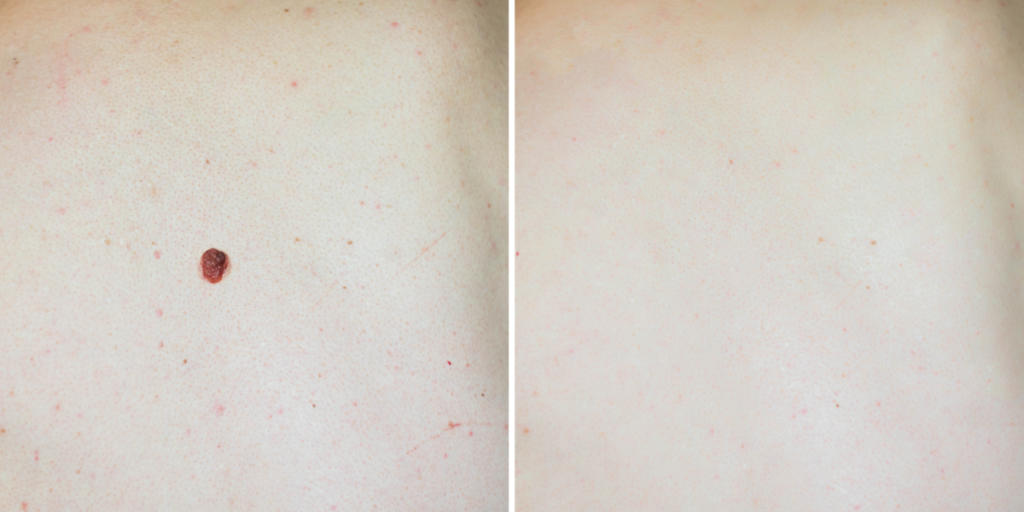
Moles and skin tags are among the most common types of skin growth. Moles are generally small, dark brown spots that can be flat or raised, appearing anywhere on the skin. Skin tags, however, are soft, flesh-colored growths that typically develop in areas where the skin folds, such as the neck or armpits. Both types of growth are usually harmless but can sometimes cause discomfort or cosmetic concerns. While moles can be a potential indicator of skin cancer if they change appearance, skin tags do not pose any health risks.
Distinguishing Between Moles and Skin Tags
Moles are generally round or oval spots ranging from light brown to almost black. They can be flat or raised and may appear anywhere on the skin. While most moles are harmless, some can become melanoma, a type of skin cancer. It’s important to monitor moles for size, color, or shape changes, as these could be warning signs.
Skin tags are small, soft growths typically flesh-colored, often hanging off the skin. They frequently develop in areas where the skin folds, such as the neck, armpits, and groin. Unlike moles, skin tags are not linked to skin cancer and generally don’t pose any health risks.
Understanding these differences can help determine the best monitoring approach and potential removal.
Deciding When to Remove
There are various reasons someone might choose to remove moles or skin tags. Medically, moles should be removed if they exhibit signs of potential malignancy, such as asymmetry, irregular borders, changes in color, or an increase in diameter. Skin tags, although not dangerous, can be removed if they become irritated by clothing or jewelry.
From a cosmetic perspective, individuals may opt to remove moles or skin tags if they are in visible areas and affect one’s self-esteem. Personal choice plays a significant role in deciding whether or not to pursue removal.
Seeking professional advice can help determine the best action for safe and effective removal.
Expert Removal Solutions
Consulting a dermatologist ensures that moles and skin tags are removed safely and effectively. Dermatologists use procedures like excision, which involves surgically removing the growth, or cryotherapy, where liquid nitrogen is used to freeze and eliminate it.
Experts at places like Queen City Plastic Surgery use specialized techniques to minimize scarring and promote quick recovery. Expert intervention is crucial for potentially cancerous moles or those in sensitive areas.
Advanced methods such as electrosurgery offer additional options for precise removal. These procedures are generally quick, performed under local anesthesia, and have a lower complication risk than DIY methods.
Dermatologists can also provide a proper diagnosis before removal, ensuring that the growth does not indicate a more serious condition. Professional evaluations are essential for peace of mind and optimal outcomes in skin health.
Post-Removal Care and Recovery
Proper skin care is essential to promote healing and prevent infection after removing moles or skin tags. First, ensure the area remains clean by gently washing it with mild soap and water. Pat it dry with a clean towel, avoiding any rough scrubbing that could irritate the skin. Your healthcare provider may prescribe an ointment to apply to the site; follow their instructions carefully to help prevent scarring and infection.
Refrain from picking or scratching the removal site, this can disrupt the healing process and increase the risk of scarring. If a bandage is applied, change it as your healthcare professional directs. Keep the area covered initially to protect it from bacteria and further irritation.
Some redness and mild discomfort are normal during the healing phase. Over-the-counter pain relievers can help manage any discomfort. However, avoid anti-inflammatory medications like aspirin unless advised by your doctor, as they can thin the blood and potentially slow down healing.
Protect the area from sun exposure by covering it with clothing or using sunscreen once the skin has healed sufficiently. Sun protection can help prevent pigmentation changes and ensure a more even skin tone as the area heals. Avoid activities that may cause excessive sweating, as moisture can interfere with proper healing. Follow any specific post-care instructions your healthcare provider provides for the best results.
Summary and Closing Remarks
Properly addressing moles and skin tags involves understanding their characteristics and knowing when removal might be necessary. While moles can sometimes indicate skin cancer and should be monitored for changes, skin tags are typically benign. Whether the concern is medical or cosmetic, various removal options are available, ranging from DIY methods to professional treatments. Consulting with a Plastic Surgeon ensures the removal is safe and effective, particularly for growths requiring more specialized care. Post-removal care is crucial to promote healing and prevent complications. Prioritize safety and consult with professionals, such as those at Queen City Plastic Surgery, to achieve the best results for your skin health.
For More Information
Are you ready to transform your appearance? If so, you are in good hands with “Charlotte Top Doc”, Dr. Enam Haque. To book a consultation for any of your skincare or plastic surgery questions, contact the offices of Queen City Plastic Surgery at 704-859-2449 or use our simple online form. Our conveniently located Charlotte office welcomes patients from throughout the region and country.
